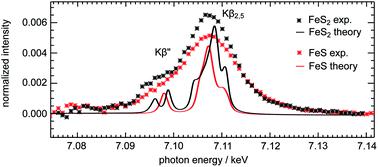当前位置:
X-MOL 学术
›
J. Anal. At. Spectrom.
›
论文详情
Our official English website, www.x-mol.net, welcomes your
feedback! (Note: you will need to create a separate account there.)
Speciation of iron sulfide compounds by means of X-ray emission spectroscopy using a compact full-cylinder von Hamos spectrometer
Journal of Analytical Atomic Spectrometry ( IF 3.1 ) Pub Date : 2020-08-27 , DOI: 10.1039/d0ja00244e Malte Wansleben 1, 2, 3, 4, 5 , John Vinson 6, 7, 8 , André Wählisch 1, 2, 3 , Karina Bzheumikhova 1, 2, 3 , Philipp Hönicke 1, 2, 3 , Burkhard Beckhoff 1, 2, 3 , Yves Kayser 1, 2, 3
Journal of Analytical Atomic Spectrometry ( IF 3.1 ) Pub Date : 2020-08-27 , DOI: 10.1039/d0ja00244e Malte Wansleben 1, 2, 3, 4, 5 , John Vinson 6, 7, 8 , André Wählisch 1, 2, 3 , Karina Bzheumikhova 1, 2, 3 , Philipp Hönicke 1, 2, 3 , Burkhard Beckhoff 1, 2, 3 , Yves Kayser 1, 2, 3
Affiliation

|
We present experimental and theoretical X-ray emission spectroscopy (XES) data of the Fe Kβ line for iron(II)sulfide (FeS) and iron(II)disulfide (FeS2). In comparison to X-ray absorption spectroscopy (XAS), XES offers different discrimination capabilities for chemical speciation, depending on the valence states of the compounds probed and, more importantly in view of a broader, laboratory-based use, greater flexibility with respect to the excitation source used. The experimental Fe Kβ XES data were recorded using polychromatic X-ray radiation and a compact full-cylinder von Hamos spectrometer while the calculations were realized using the OCEAN code. The von Hamos spectrometer used is characterized by an energy window of up to 700 eV and a spectral resolving power of E/ΔE = 800. The large energy window coverey by the spectrometer components is beneficial to circumvent the instrumental sensitivity of wavelength-dispersive spectrometers to sample positioning. This results in a robust energy scale which is used to compare experimental data with ab initio valence-to-core calculations, which are carried out using the OCEAN package. To validate the reliability of the OCEAN package for the two sample systems, near edge X-ray absorption fine structure measurements of the Fe K absorption edge are compared to theory using the same input parameters as in the case of the X-ray emission calculations. Based on the example of iron sulfide compounds, the combination of XES experiments and OCEAN calculations allows unravelling the electronic structure of different transition metal sulfides and qualifying XES investigations for the speciation of different compounds.
中文翻译:

使用紧凑型全圆筒冯哈莫斯光谱仪通过X射线发射光谱法对硫化铁化合物进行形态分析
我们目前的实验和理论X射线发射光谱(XES)中的FeKβ线为铁(的数据II)硫醚(FES)和铁(II)二硫醚(FES 2)。与X射线吸收光谱法(XAS)相比,XES根据所探测化合物的化合价态提供不同的化学形态识别能力,更重要的是,鉴于更广泛的基于实验室的用途,XES具有更大的灵活性使用的激发源。使用多色X射线辐射和紧凑的全圆筒von Hamos光谱仪记录了实验的FeKβXES数据,同时使用OCEAN代码实现了计算。所使用的冯·哈莫斯光谱仪的特点是能量窗口高达700 eV,光谱分辨能力为E / ΔE=800。光谱仪组件所具有的大能量窗口盖有利于规避波长分散光谱仪对样品定位的仪器灵敏度。这导致了强大的能级,可用于从头算起比较实验数据价核心计算,使用OCEAN软件包进行。为了验证两个样品系统的OCEAN软件包的可靠性,使用与X射线发射计算相同的输入参数,将Fe K吸收边缘的近边缘X射线吸收精细结构测量结果与理论进行了比较。以硫化铁化合物为例,XES实验和OCEAN计算的结合可以揭示不同过渡金属硫化物的电子结构,并可以鉴定XES研究各种化合物的形态。
更新日期:2020-11-03
中文翻译:

使用紧凑型全圆筒冯哈莫斯光谱仪通过X射线发射光谱法对硫化铁化合物进行形态分析
我们目前的实验和理论X射线发射光谱(XES)中的FeKβ线为铁(的数据II)硫醚(FES)和铁(II)二硫醚(FES 2)。与X射线吸收光谱法(XAS)相比,XES根据所探测化合物的化合价态提供不同的化学形态识别能力,更重要的是,鉴于更广泛的基于实验室的用途,XES具有更大的灵活性使用的激发源。使用多色X射线辐射和紧凑的全圆筒von Hamos光谱仪记录了实验的FeKβXES数据,同时使用OCEAN代码实现了计算。所使用的冯·哈莫斯光谱仪的特点是能量窗口高达700 eV,光谱分辨能力为E / ΔE=800。光谱仪组件所具有的大能量窗口盖有利于规避波长分散光谱仪对样品定位的仪器灵敏度。这导致了强大的能级,可用于从头算起比较实验数据价核心计算,使用OCEAN软件包进行。为了验证两个样品系统的OCEAN软件包的可靠性,使用与X射线发射计算相同的输入参数,将Fe K吸收边缘的近边缘X射线吸收精细结构测量结果与理论进行了比较。以硫化铁化合物为例,XES实验和OCEAN计算的结合可以揭示不同过渡金属硫化物的电子结构,并可以鉴定XES研究各种化合物的形态。











































 京公网安备 11010802027423号
京公网安备 11010802027423号